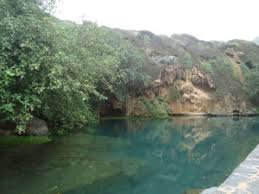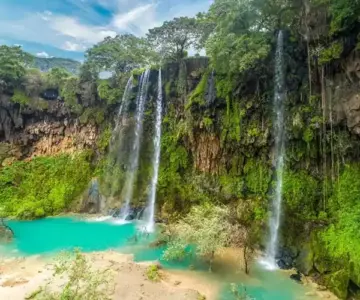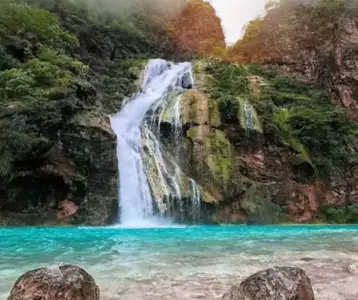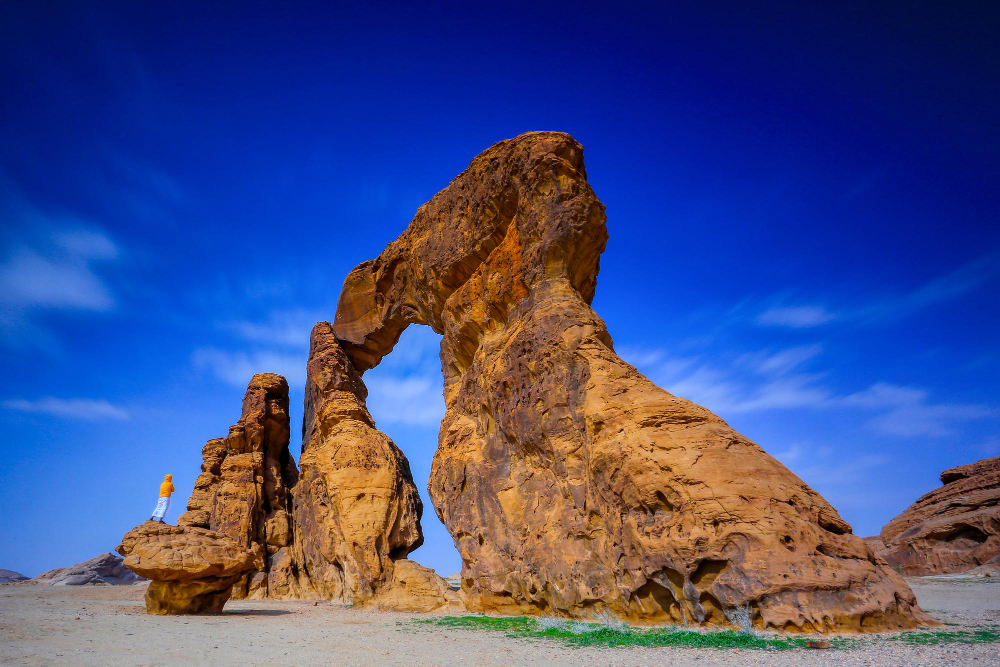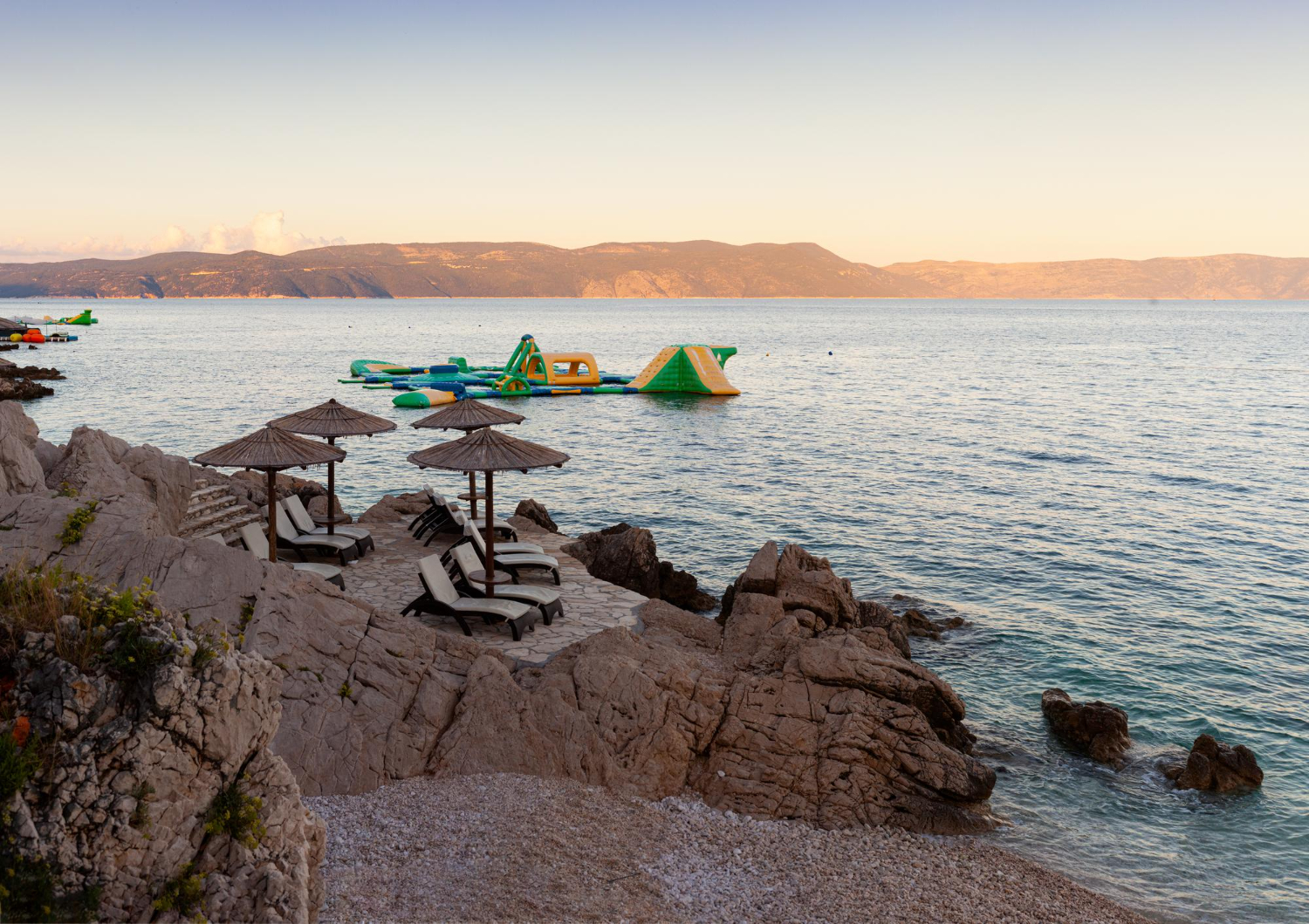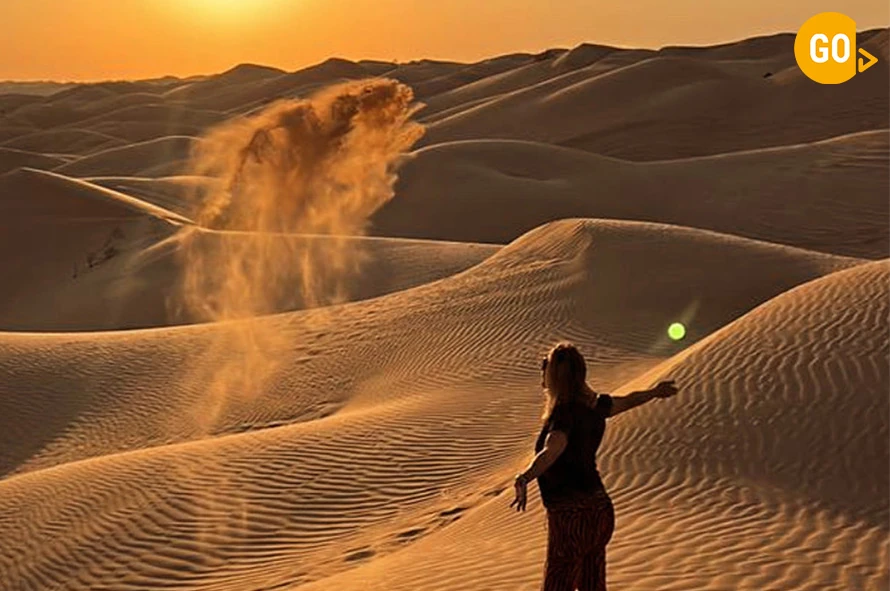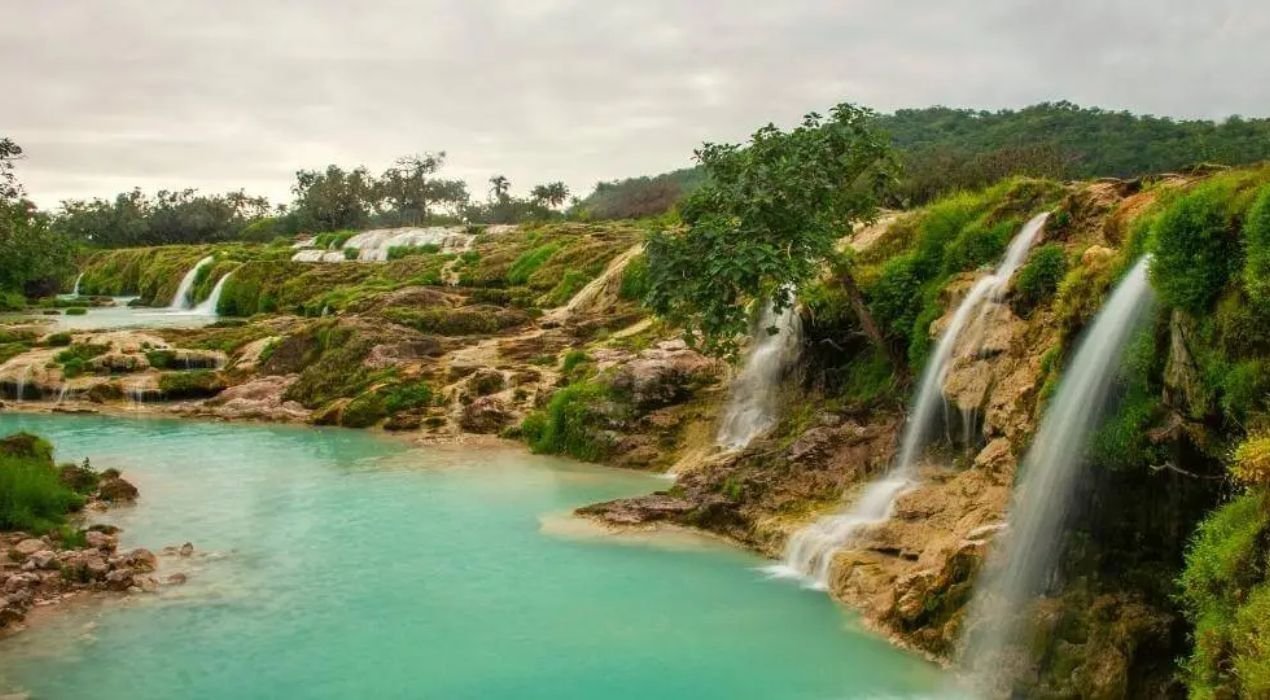Information about Ayn Sahalnoot Salalah
Nestled in the lush landscapes of Oman’s southern region, Ayn Sahalnoot stands as a testament to the breathtaking beauty that nature can offer. This enchanting destination, located just a short drive from Salalah city, has become increasingly popular among both locals and tourists seeking to immerse themselves in the raw splendor of Dhofar’s natural wonders.
As visitors approach Ayn Sahalnoot Salalah, they are greeted by a mesmerizing panorama of verdant mountains, cascading waterfalls, and a serene spring that seems to breathe life into the surrounding valley. The area’s unique microclimate, influenced by the annual khareef season, transforms this already picturesque location into a veritable paradise, drawing nature enthusiasts, photographers, and families alike.
In this comprehensive guide, we’ll explore the many facets of Ayn Sahalnoot, from its geological significance to the myriad activities available for visitors. We’ll delve into the best times to visit, how to get there, and what to expect when you arrive. Whether you’re planning a day trip or looking to include Ayn Sahalnoot in a broader Salalah itinerary, this article will provide you with all the information you need to make the most of your visit to this extraordinary natural attraction.

The Geological Marvel of Ayn Sahalnoot
Ayn Sahalnoot’s formation is a fascinating tale written in stone over millions of years. The area’s unique geological features have been shaped by tectonic movements and erosion, resulting in the dramatic landscape we see today.
Formation of the Spring
At the heart of Ayn Sahalnoot lies its namesake spring, a natural wonder that has captivated visitors for generations. The spring’s origins can be traced back to the complex network of underground aquifers that crisscross the Dhofar region. These subterranean water channels, formed by the porous limestone bedrock, allow rainwater to percolate through layers of rock before emerging as crystal-clear springs.
The water’s journey through the earth not only purifies it but also enriches it with minerals, giving Ayn Sahalnoot’s spring its reputation for purity and potential health benefits. The constant flow of water has, over time, carved out the surrounding rock, creating the picturesque pools and cascades that characterize the area.
Surrounding Mountain Landscape
The mountains encircling Ayn Sahalnoot are part of the larger Dhofar mountain range, which runs along Oman’s southern coast. These mountains play a crucial role in the region’s unique climate, acting as a natural barrier that captures moisture from the Indian Ocean monsoons, leading to the lush vegetation that blankets the area during the khareef season.
The rock composition of these mountains, primarily limestone and sandstone, contributes to the area’s striking appearance. Erosion has sculpted the landscape over millennia, creating steep cliffs, hidden caves, and the winding valleys that make Ayn Sahalnoot such a visually stunning destination.
Biodiversity Hotspot
The geological diversity of Ayn Sahalnoot has given rise to a rich tapestry of ecosystems. The combination of abundant water, varied terrain, and mild climate has created numerous microhabitats, each supporting a unique array of flora and fauna.
From the hardy plants that cling to rocky outcrops to the lush vegetation surrounding the spring, Ayn Sahalnoot showcases the adaptability of life in this semi-arid region. The area serves as a vital water source for local wildlife, making it an excellent spot for nature observation and photography.
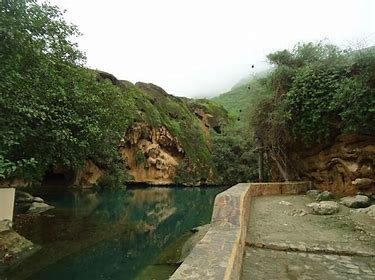
The Cultural Significance of Ayn Sahalnoot
Beyond its natural beauty, Ayn Sahalnoot holds a special place in the cultural fabric of the Dhofar region. The spring and its surrounding area have been intertwined with local traditions and livelihoods for centuries.
Historical Importance
For generations, Ayn Sahalnoot has served as a crucial water source for local communities. In a region where water is a precious commodity, the reliable flow of the spring has made it a focal point for human settlement and activity. Archaeological evidence suggests that the area has been inhabited for thousands of years, with ancient tribes recognizing the strategic importance of this water-rich oasis.
The spring’s significance extends beyond mere practicality. In local folklore, Ayn Sahalnoot is often associated with tales of healing and rejuvenation. Many believe that the water possesses special properties, a belief that continues to draw visitors seeking its purported benefits.
Traditional Uses
Historically, the communities around Ayn Sahalnoot have relied on its waters for various purposes. The spring has been used for drinking water, irrigation of small agricultural plots, and watering livestock. The surrounding vegetation, nourished by the spring, has provided fodder for animals and materials for traditional crafts.
During times of drought, Ayn Sahalnoot’s importance would be magnified, serving as a lifeline for both humans and animals in the region. This reliance on the spring has fostered a deep respect for the natural environment among local populations, contributing to conservation efforts in modern times.
Modern Cultural Relevance
Today, while modern infrastructure has reduced the direct reliance on Ayn Sahalnoot for daily water needs, the site remains culturally significant. It has become a popular gathering place for local families, especially during the khareef season when the area is at its most verdant.
The spring also plays a role in contemporary Omani tourism, showcasing the natural beauty and cultural heritage of the Dhofar region to visitors from around the world. As such, it serves as a bridge between Oman’s rich past and its developing future, highlighting the importance of preserving natural resources in the face of modernization.

The Unique Climate of Ayn Sahalnoot
One of the most remarkable aspects of Ayn Sahalnoot is its distinctive microclimate, which sets it apart from the surrounding arid landscape of southern Oman. This unique weather pattern not only contributes to the area’s lush vegetation but also makes it a popular destination throughout the year.
The Khareef Season
The khareef, or monsoon season, is perhaps the most defining climatic feature of the Dhofar region, including Ayn Sahalnoot. This annual phenomenon typically occurs between June and September, transforming the landscape into a verdant paradise.
During the khareef, moisture-laden winds from the Indian Ocean are forced upwards by the Dhofar Mountains, causing them to cool and condense. This results in a persistent mist and light drizzle that blankets the region, nourishing the vegetation and replenishing water sources like Ayn Sahalnoot.
The effect on Ayn Sahalnoot during this period is nothing short of magical. The already beautiful landscape bursts into life, with the hills and valleys carpeted in lush greenery. The spring’s flow is often at its strongest during this time, creating mesmerizing cascades and pools.
Year-round Climate
While the khareef season is undoubtedly the most dramatic time at Ayn Sahalnoot, the area’s climate remains relatively mild throughout the year. The elevation of the site, combined with its proximity to the ocean, helps moderate temperatures even during the hottest months.
In the winter months (December to February), temperatures can be quite cool, especially in the early mornings and evenings. This makes it an ideal time for hiking and exploring the surrounding landscape without the humidity of the khareef season.
Spring and autumn offer pleasant intermediate conditions, with comfortable temperatures and occasional rainfall that keeps the vegetation green long after the khareef has ended.
Microclimates Within Ayn Sahalnoot
The varied topography of Ayn Sahalnoot creates several microclimates within the area itself. The spring and its immediate surroundings maintain a cooler, more humid environment year-round due to the constant presence of water. This creates a stark contrast with the drier, warmer conditions found on the upper slopes of the surrounding hills.
These microclimates support a diverse range of plant and animal life, contributing to the area’s ecological importance and its appeal to nature enthusiasts and researchers alike.
Flora and Fauna of Ayn Sahalnoot
The unique climate and geological features of Ayn Sahalnoot have given rise to a rich and diverse ecosystem, making it a haven for various plant and animal species. This biodiversity not only enhances the area’s natural beauty but also contributes to its ecological significance.
Plant Life
The vegetation around Ayn Sahalnoot is characterized by its lushness and variety, especially during and immediately after the khareef season. The constant availability of water from the spring supports a year-round green belt in its immediate vicinity.
Some of the notable plant species found in the area include:
- Frankincense trees (Boswellia sacra): These iconic trees, famous for their aromatic resin, are native to the region and can be found on the drier slopes surrounding Ayn Sahalnoot.
- Acacias: Various species of acacia trees and shrubs dot the landscape, providing important habitats for local wildlife.
- Figs: Wild fig trees often grow near water sources like Ayn Sahalnoot, their roots helping to stabilize the soil.
- Aloes: Several species of aloe, known for their medicinal properties, thrive in the area’s semi-arid climate.
- Grasses and sedges: During the khareef, the hills around Ayn Sahalnoot are covered in a carpet of green grasses and sedges.
The plant life not only adds to the visual appeal of Ayn Sahalnoot but also plays a crucial role in preventing soil erosion and maintaining the local water cycle.
Wildlife
The diverse habitats created by Ayn Sahalnoot’s spring and surrounding terrain support a wide array of animal life. While some species are permanent residents, others are seasonal visitors or migratory species that use the area as a stopover.
Some of the wildlife that visitors might encounter include:
- Arabian Gazelle: These graceful animals can sometimes be spotted in the early morning or late afternoon, coming to the spring to drink.
- Rock Hyrax: These small, rabbit-like mammals are often seen sunning themselves on rocky outcrops.
- Various bird species: The area is a birdwatcher’s paradise, with species like the Egyptian vulture, Bonelli’s eagle, and various warblers and sunbirds frequenting the area.
- Reptiles: Several species of lizards and snakes call Ayn Sahalnoot home, including the colorful Oman lizard.
- Insects: The area is rich in insect life, including butterflies, dragonflies, and various beetle species.
It’s important to note that while wildlife sightings can enhance the visitor experience, all animals should be observed from a respectful distance to ensure their well-being and preserve the natural balance of the ecosystem.
Conservation Efforts
Recognizing the ecological importance of Ayn Sahalnoot, local authorities and conservation organizations have implemented various measures to protect its biodiversity. These efforts include:
- Controlled access to sensitive areas
- Educational programs to raise awareness about the area’s unique ecosystem
- Monitoring of plant and animal populations
- Initiatives to combat invasive species that could threaten native flora and fauna
Visitors to Ayn Sahalnoot are encouraged to practice responsible tourism, following guidelines to minimize their impact on this delicate ecosystem.
Best Times to Visit Ayn Sahalnoot
Choosing the right time to visit Ayn Sahalnoot can greatly enhance your experience of this natural wonder. While the area’s beauty is evident year-round, certain seasons offer unique attractions and atmospheres.
Khareef Season (June to September)
The khareef, or monsoon season, is undoubtedly the most popular time to visit Ayn Sahalnoot. During these months, the landscape is transformed into a lush, green paradise, with misty hills and flowing waterfalls creating a surreal atmosphere.
Advantages of visiting during khareef:
- Spectacular green landscapes
- Stronger water flow in the spring and waterfalls
- Pleasant, cool temperatures
- Unique misty atmosphere
Considerations:
- Larger crowds, especially on weekends and holidays
- Some trails may be slippery due to constant moisture
- Reduced visibility on some days due to heavy mist
Post-Khareef (October to November)
The months immediately following the khareef offer a beautiful balance. The landscape remains green and lush, but the mists have cleared, providing excellent visibility for photography and sightseeing.
Advantages:
- Clear skies for better views and photography
- Comfortable temperatures
- Less crowded than during peak khareef
- Trails are drier and easier to navigate
Considerations:
- Water flow in the spring may be reduced compared to khareef season
Winter Season (December to February)
Winter brings cooler temperatures to Ayn Sahalnoot, making it an ideal time for hiking and outdoor activities. The landscape may not be as green as during khareef, but it has its own stark beauty.
Advantages:
- Perfect weather for hiking and exploration
- Clearest skies, offering expansive views
- Ideal for wildlife watching, as animals are more active in cooler weather
Considerations:
- Nights and early mornings can be quite cool
- Vegetation is less lush compared to khareef season
Spring Season (March to May)
Spring sees temperatures beginning to rise, but the weather remains pleasant for outdoor activities. This is a good time to visit before the summer heat sets in.
Advantages:
- Comfortable daytime temperatures
- Possibility of seeing spring wildflowers
- Less crowded than peak seasons
Considerations:
- Landscape may be drier compared to khareef and winter seasons
- Afternoons can be warm
Time of Day Considerations
Regardless of the season, the time of day you visit Ayn Sahalnoot can significantly impact your experience:
- Early Morning: Ideal for wildlife watching and photography. The light is soft, and temperatures are cool.
- Midday: Best avoided during warmer months due to high temperatures and harsh light for photography.
- Late Afternoon: Another excellent time for photography as the setting sun casts a warm glow over the landscape.
- Evening: Perfect for enjoying the tranquility of the area and possibly stargazing on clear nights.
By considering these seasonal and daily variations, visitors can plan their trip to Ayn Sahalnoot to best suit their interests and preferences, ensuring a memorable experience in this natural wonderland.
How to Reach Ayn Sahalnoot
Accessing Ayn Sahalnoot is relatively straightforward, thanks to its proximity to Salalah city. However, understanding the various transportation options and route details can help visitors plan their trip more effectively.
By Car
Driving to Ayn Sahalnoot is the most popular and flexible option for visitors. The spring is located approximately 15 kilometers northeast of Salalah city center.
Directions:
- From Salalah, head north on the main highway towards Thumrait.
- After about 10 kilometers, you’ll see a sign for Ayn Sahalnoot. Take the right turn here.
- Follow this road for about 5 kilometers until you reach the parking area for Ayn Sahalnoot.
Tips for driving:
- The roads are generally well-maintained, but the final stretch can be narrow with some sharp bends.
- During khareef season, be prepared for misty conditions and potentially slippery roads.
- A 4×4 vehicle is not necessary for reaching the main parking area, but it can be useful if you plan to explore further into the surrounding hills.
By Taxi
For those without their own transportation, taxis are readily available in Salalah and can take you to Ayn Sahalnoot.
Tips for taking a taxi:
- Agree on the fare before starting the journey. Most taxis do not use meters for out-of-town trips.
- Consider arranging for the taxi to wait and return you to Salalah, as finding a taxi at Ayn Sahalnoot for the return journey may be challenging.
- Expect to pay more during the peak khareef season when demand is high.
By Tour Operator
Many local tour operators in Salalah offer day trips or half-day excursions to Ayn Sahalnoot, often combined with visits to other nearby attractions.
Advantages of going with a tour:
- Transportation is taken care of
- Guides can provide historical and cultural context
- Often includes stops at other points of interest in the area
- Can be a good option for solo travelers or those unfamiliar with the region
Public Transportation
While there is no direct public transportation to Ayn Sahalnoot, adventurous travelers can take a public bus towards Thumrait and ask to be dropped off at the turn-off for Ayn Sahalnoot. From there, it’s a 5-kilometer walk to the site. This option is not recommended during the hot summer months or for those with limited mobility.
Hiking
For the truly adventurous, it’s possible to hike to Ayn Sahalnoot from the outskirts of Salalah. This should only be attempted by experienced hikers with proper equipment and preferably a local guide, as the terrain can be challenging and navigation tricky.
Accessibility Considerations
- The main viewing area of Ayn Sahalnoot is accessible via a paved path from the parking lot.
- Exploring beyond the immediate area of the spring involves uneven terrain and may not be suitable for those with mobility issues.
- During peak seasons, parking can fill up quickly, especially on weekends and holidays.
By understanding these transportation options, visitors can choose the method that best suits their needs, ensuring a smooth and enjoyable journey to one of Salalah’s most beautiful natural attractions.
Activities and Experiences at Ayn Sahalnoot
Ayn Sahalnoot offers a diverse range of activities and experiences for visitors, catering to various interests and fitness levels. From relaxing picnics to adventurous hikes, there’s something for everyone at this natural oasis.
Sightseeing and Photography
The breathtaking scenery of Ayn Sahalnoot makes it a paradise for photographers and nature enthusiasts. The interplay of light and mist during the khareef season creates ethereal scenes that are particularly captivating.
Key photo opportunities include:
- The main spring and its cascading waters
- Panoramic views from surrounding hilltops
- Lush vegetation during and after the khareef season
- Wildlife, especially birds and small mammals
Tips for photographers:
- Early morning and late afternoon offer the best light for landscape photography
- Bring a tripod for long-exposure shots of the flowing water
- A wide-angle lens can help capture the expansive landscapes
- Consider using a polarizing filter to reduce glare from wet surfaces
Hiking and Exploration
The area around Ayn Sahalnoot boasts numerous hiking trails of varying difficulty, allowing visitors to immerse themselves in the natural beauty of the region.
Popular hiking routes:
- Spring Loop Trail: An easy 1-kilometer trail circling the main spring area
- Hilltop Panorama Trail: A moderate 3-kilometer hike offering stunning views of the surrounding landscape
- Valley Explorer Route: A more challenging 5-kilometer trek through the nearby wadi
Hiking safety tips:
- Wear sturdy, comfortable footwear with good traction
- Bring plenty of water, especially during warmer months
- Inform someone of your hiking plans if venturing on longer trails
- Be aware of weather conditions, particularly during khareef when trails can be slippery
Picnicking and Relaxation
Many visitors come to Ayn Sahalnoot to enjoy a peaceful picnic amidst nature. The area around the spring provides ideal spots for setting up a picnic and enjoying the serene atmosphere.
Picnic tips:
- Bring a waterproof blanket or mat to sit on, especially during khareef
- Pack light, easily transportable food and drinks
- Dispose of all waste properly to preserve the natural environment
- Consider bringing a small portable stove for hot beverages or light cooking
Wildlife Watching
Ayn Sahalnoot’s diverse ecosystem makes it an excellent location for wildlife observation, particularly birdwatching.
Wildlife watching tips:
- Bring binoculars for better viewing
- Move quietly and avoid disturbing animals
- Early morning and late afternoon are the best times for wildlife activity
- Consider joining a guided nature walk for expert insights
Cultural Experiences
While Ayn Sahalnoot itself is a natural attraction, the surrounding area offers opportunities to experience local Dhofari culture.
Cultural activities near Ayn Sahalnoot:
- Visit nearby frankincense groves and learn about this historically significant resin
- Explore traditional Dhofari villages in the vicinity
- Attend local festivals and events, especially during the khareef season
Adventure Activities
For thrill-seekers, the area around Ayn Sahalnoot offers some exciting adventure opportunities:
- Rock climbing: With proper equipment and guidance, some of the rocky outcrops provide challenging climbs
- Canyoning: Explore the nearby wadis through a combination of hiking, swimming, and rappelling (only with experienced guides)
- Mountain biking: Some tour operators offer mountain biking excursions in the surrounding hills
Wellness and Meditation
The tranquil environment of Ayn Sahalnoot makes it an ideal spot for those seeking peace and relaxation.
Wellness activities:
- Yoga and meditation sessions (some tour operators offer guided sessions)
- Nature therapy walks
- Simply sitting by the spring and enjoying the soothing sounds of flowing water
Educational Experiences
Ayn Sahalnoot serves as a living classroom for those interested in geology, botany, and ecology.
Educational opportunities:
- Guided nature walks focusing on local flora and fauna
- Geology tours explaining the formation of the spring and surrounding landscape
- Environmental conservation workshops (occasionally offered by local organizations)
Night Sky Observation
On clear nights, especially during the cooler months, Ayn Sahalnoot’s relatively dark skies offer good conditions for stargazing.
Stargazing tips:
- Check the lunar calendar and try to visit during a new moon for the darkest skies
- Bring a star chart or download a stargazing app to help identify constellations
- Consider bringing a small telescope or powerful binoculars for a closer look at celestial objects
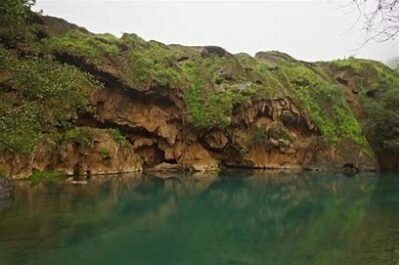
Seasonal Activities
Depending on the time of year, visitors can engage in various seasonal activities:
- Khareef season: Mist walks and photography of the lush, green landscape
- Spring: Wildflower spotting and butterfly watching
- Winter: Ideal conditions for longer hikes and outdoor exploration
By offering such a wide array of activities and experiences, Ayn Sahalnoot caters to diverse interests and ensures that visitors can enjoy this natural wonder in multiple ways. Whether seeking adventure, relaxation, or education, there’s an activity to suit every preference at this remarkable destination.
Local Customs and Etiquette
When visiting Ayn Sahalnoot, it’s important to be mindful of local customs and etiquette to ensure a respectful and harmonious experience for all. Oman, including the Dhofar region where Ayn Sahalnoot is located, has a rich cultural heritage and traditional values that visitors should be aware of.
Dress Code
While Ayn Sahalnoot is a natural area, it’s still important to dress modestly out of respect for local customs:
- For women: Shoulders and knees should be covered. Loose-fitting, breathable clothing is ideal.
- For men: Shorts that cover the knees and shirts that cover the shoulders are appropriate.
- Avoid wearing revealing or tight-fitting clothing.
Photography Etiquette
While photographing the natural landscape is encouraged, be mindful when taking pictures of people:
- Always ask permission before photographing local people, especially women and children.
- Some traditional Omanis may not want their picture taken for cultural or religious reasons.
- Avoid photographing military installations or government buildings.
Respect for the Environment
Preserving the natural beauty of Ayn Sahalnoot is crucial:
- Follow the “Leave No Trace” principles: pack out all trash, stay on designated trails, and don’t disturb wildlife or plants.
- Avoid picking flowers or collecting rocks as souvenirs.
- Do not swim in or contaminate the spring water, as it’s a vital resource for local communities.
Don’t miss the opportunity to explore the natural beauty of Ayn Sahalnoot Salalah through Salalah Activities.

